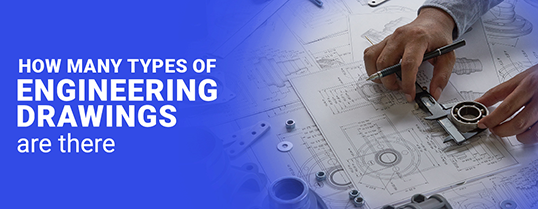How Many Types of Engineering Drawings Are There
December 2, 2022
Engineering drawings are a type of technical drawing that encapsulates a wide variety of complex data and information. Since engineering problems require in-depth analysis and problem-solving, technical drawings often come to the rescue for solving such complex problems. Elements in engineering drawing that are represented by a technical drawing convey designs and specifications, physical objects and relationships. As the engineering drawing requires to be extremely precise and to the point, it is here where CAD design comes into the picture. CAD/GIS designs are a type of technical drawing widely used for conceptual design and layout of products to define manufacturing of components. CAD design helps in achieving greater efficiency and accuracy in engineering drawing. Let us understand the different types of engineering drawings.
Isometric Drawings- Commonly called isometric projection, this type of drawing is widely used by engineers, architects, and technicians. The major purpose of isometric drawings is to convey the illusion of depth and perspective rendering. The isometric drawing is capable of conveying a huge amount of information like actual details and dimensions about the model. It is apt for creating 3D models with extremely fine precision.
Assembly Drawings- If your model contains more than one component, then assembly drawings will be the ideal option. This kind of drawing essentially shows how the components will fit together and these may include sections, elevations, three-dimensional views, and more. As the name suggests, assembly drawings can showcase how to assemble part of a model like a complex part of a building. With a better-printed engineering drawing with a good-performing large-format printer, you can get remarkable quality prints that help you better understand the components. One such printer would be the Canon PlotWave 3000/3500.
Parametric Drawings- Parametric drawing is a method for making geometries with geometrical constraints. Adopting a parametric approach to engineering drawings has significant advantages over the traditional non-parametric approach. A parametric drawing comes to use when, for example, you want to change something in the drawings even after the entire designing part is over. Making the changes manually is an immensely tedious process. But, with a parametric drawing, the design automatically updates any error, thereby minimizing human interference.
Fabrication Drawings- The importance of these kinds of drawings are often overlooked. Fabrication drawings are a type of engineering drawing that can communicate important steps in complex construction. A feature of a top-notch fabrication drawing is that it will give the on-site contractor accurate measurements and dimensions. The complex nature of the fabrication drawing is such that it perfectly represents elevations, sections, data, and dimensions. The drawings are made with the highest level of accuracy and ensure no delay or damage in the construction process.

